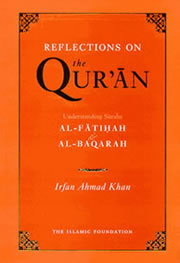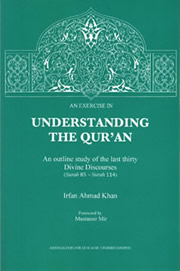For those who want to focus on the Divine Text itself, it is important that the Divine Signs themselves should strike directly their hearts and minds. The Qur’an repeatedly reports that the believers enjoy when they recite the Divine Signs (10: 57-58, 13:36) and contemplate over their meanings.
In order to understand the Book with one’s own mind/heart, an actual contact with the Divine Words has to take place through hearing, seeing and/or touching. Certain conditions can succeed in inducing an inspiration by putting our fu’ad (mind/heart) to work. In fact, when God’s Message, in His Own Words, touches one’s innermost being the whole of one’s being feels its resonance for quite some time. And, it is possible to have a lifetime impression. We do not deny the role of memory and imagination, but memory and imagination need experiential bases (of the original physical contacts) which are provided through the above three channels.
Reciting the Qur’an or listening to a recitation is the first and foremost mode through which the above contact takes place. One’s feeling that the Lord is speaking directly to His servant (me) who has a heart and listens with full attention (50:37) can bring the servant closer to the Qur’an. As the Prophet himself suggested, every believer is supposed to develop some taste for the music of the Qur’anic Ayat (Verses). The time after midnight was suggested to the Prophet (73:1-6) himself for quiet moments of reflection upon the Divine Ayat. However, it is at this time that some other servants of God also stand up for their prayers (73:20) after having taken some rest. All around, there is a perfect peace and calm, because everyone else is asleep. Likewise, the fajr (dawn, before sunrise Salah) time would provide an excellent time for listening to God’s Words (17:78).
But hearing is not the only medium through which a touch of Divine Ayat is experienced. Seeing, which every so often goes along with reciting, also plays an important role in this connection. In fact, seeing provides a more stable medium for our faculty of understanding. In listening to recitation there is a continuous forward movement of our faculty of hearing which our fu’ad (understanding) has to chase and sometimes this movement may be too fast for our reflection. This is why sometime qira’ah, i.e. recitation of the Qur’an with slower speed, makes more intensive reflection possible. At the same time, we also need a faster review of the whole span of Ayat. Or maybe our fu’ad needs a brief stop to have a look at the whole Ayah, or even part of an Ayah, or set of Ayat, or even a whole Surah (Chapter). In such cases our faculty of seeing helps the person who is reading. As opposed to hearing, which has to keep running forward along the recitation in order to decipher the flux of musical sound, our sight is capable of having a comparatively stationary view, of a whole set of Ayat or even the whole of a smaller Surah in one look.
We must not ignore here the significance of touching the Ayat with our fingers. The finger-touch helps our forward-moving sight to take better snapshots of more elementary parts of Divine Ayat. Our sight, when assisted by our finger touch, possesses even greater stability and makes consideration of each word/phrase easier for fu’ad.
It is also important to note that, whatever be the channel, the purity of the object actually touched, seen, or heard counts for a real impact and a clearer grasp of meaning. For example, in having overlooked the Divine Words, a mushaf (the Scripture, i.e. the Qur’an) without its translation is much more helpful in understanding the Divine Signs, their meanings and structure. For a reader who knows sufficient Arabic, a mushaf with translation or other help-material, would act as a hindrance to the eyes and thereby to the fu’ad of every reader who can easily understand the language. Readers are, therefore, requested to apply their eyes to the pure Text. If they have difficulty in understanding due to their poor knowledge of the Arabic language, (which we urge them to make up as soon as possible), they are requested to first seek help from some translation of the Text in order to see/listen directly to God’s Words – free of any foreign elements.
Building up a relationship with Divine Words means, more than anything else, building our relationship with Divine Ayat (of the Qur’an), reading/ reciting them or listening to their recitation over and over again – as we reflect over their meanings and walk in their light (39:22). Ayat of the Qur’an invite us to thinking– they have a message for us. Every Ayah makes a point which needs to be reflected upon. In fact, an “Ayah” means “something significant, which needs to be understood.” But there are other levels on which contact is build up with the Divine Words, some of them lower but some even higher than that of Ayatic reflection. Therefore, before we proceed further, let us have a look at more significant levels on which our contact is maintained with the Divine Text.
Various Levels on Which We Build A Relationship With the Qur’anic Text:
(i) The basic level is that of letters, whether consonants (huruf, sing. harf) or vowels (harakat, sing. harakah).
No recitation is correct unless and until every harf (consonant) and every harakah (vowel) has been correctly uttered. Likewise, a good hearing will be one which does not miss any letter uttered, whether consonant or vowel. And the same will be true on writing, seeing or touching, which should also take care of each and every letter.
(ii) We must relate ourselves with each and every word of the Qur’an, whether noun or verb, adjective or adverb; even prepositions and conjunctions should be given full consideration. Sometimes we do not give due consideration to conjunctions and prepositions, and thereby miss very significant points in the understanding of the Qur’an.
The significance of conjunctions lies in showing how various statements are mutually connected, and thus conjunctions help in giving us a broader view of a complex reality whose various aspects are represented by these statements. The Qur’anic conjunctions play a very important role in showing us the structure of a Surah which alone contains a complete Divine Discourse comprising Ayat as points which are systematically related.
(iii) An Ayah of the Qur’an may comprise more than one sentence. But sometimes one gets the impression from some Ayat that, as such, one of them does not even make one complete sentence. Being successful in building a relationship with a Qur’anic Ayah would involve being able to understand the linguistic expression the Ayah makes as a whole. And this may be a very complex point – as is the case for some longer Ayat.
We may have to consider some other points concerning our relationship with Qur’anic Ayat. But first let us discuss the Surah, which is a very important unit of Revealed Guidance in Divine Words and consider how to build our relationship with the Qur’an as a whole.
(iv) The Divine Book is made up of 114 Divine Discourses or Surahs. Every Surah is a complete discourse which is very systematically organized. There is a central theme of every Surah which organizes various discussions which the Surah comprises. In fact, this is the reason why the Qur’an did not challenge (as in 2:23) its skeptical opponents, who doubted that it was Divine Revelation, to bring any number of Ayat like the Ayat of the Qur’an. The Qur’anic challenge, on the other hand was related to ten Surahs (11:13) or even one Surah of the Qur’an (2:23; 10:38) or the Qur’an as a whole (17:88).
Also have a look at the Outline and Structure of Surah al-Fatihah. In order to appreciate the systematic structure of the Qur’anic Surahs, a learner should select a short Surah and keep reading it over and over again, till its structure becomes clear to him/her and he/she is able to see what is the main point which the Surah makes and how it is actually made in this Divine Discourse.
(v) Significance of Ramadan: Just as the Qur’anic Surahs are very well organized units of the Qur’an, within the Qur’an its Surahs are very systematically arranged. During the month of Ramadan the Muslim Community has a very special program in which the believers build their relationship with the Book as a whole.
Throughout the year the believers relate themselves with the Qur’anic Surahs, reciting the Surahs one after another and reflecting over the Ayat of these Divine Discourses. However, when Ramadan arrives, there is a month-long annual celebration of the Qur’anic Revelation. (2:185). The Muslim Community tries to build its relationship with the Qur’an as a whole, reciting the Qur’an and listening to the recitation of the Qur’an as much as possible. During the day the believers fast, and at night they perform special additional prayers to listen to at least one complete recitation of the whole of the Qur’an.
A true understanding of the Qur’anic Ayat is possible only for those who keep reciting and listening to the recitation of the whole of the Qur’an. We hope our notes on al-Fatihah and al-Baqarah will practically demonstrate this important point.


